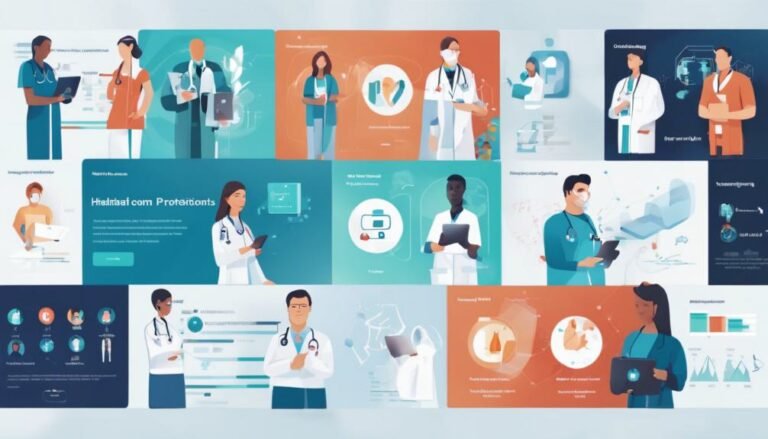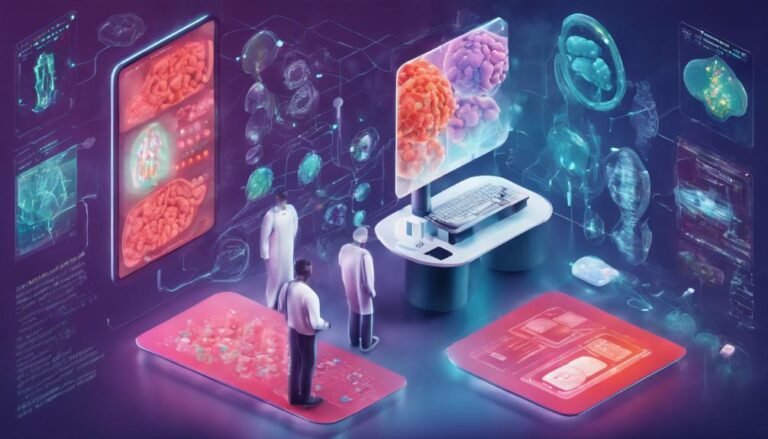AI for Public Health Policy
In the domain of public health policy, AI stands as a pivotal tool, reshaping strategies and bolstering decision-making processes. Imagine a landscape where data-driven insights not only inform policy development but also revolutionize disease surveillance methods. By delving into the depths of predictive analytics, AI holds the potential to forecast outbreaks before they unfold, optimizing resource allocation and fostering proactive interventions. But beyond the allure of technological advancements lies a sphere of ethical considerations and uncharted territories. The intersection of AI and public health policy beckons a closer examination, urging a deeper exploration into its implications and challenges.
Key Takeaways
- AI optimizes policy development through data analysis.
- Machine learning aids in early disease detection.
- Resource allocation is enhanced with data-driven insights.
- Predictive analytics forecast outbreaks for targeted interventions.
- Ethical considerations ensure responsible AI deployment in public health.
Role of AI in Policy Development
AI plays a pivotal role in streamlining and optimizing the development of public health policies. By analyzing vast amounts of data quickly and accurately, AI has a significant impact on the policy-making process. Through machine learning algorithms, AI can identify patterns, correlations, and trends that human analysts may overlook, leading to more informed decision-making.
The policy impact of AI in public health is profound. AI can predict disease outbreaks, assess the effectiveness of interventions, and optimize resource allocation. These capabilities enable policymakers to make evidence-based decisions that have a direct impact on public health outcomes. Additionally, AI can simulate different scenarios, allowing policymakers to evaluate the potential outcomes of different policy choices before implementation.
In the decision-making process, AI provides valuable insights by processing data from various sources and presenting policymakers with actionable recommendations. This streamlines the policy development process, making it more efficient and effective.
Disease Surveillance and Early Detection
Analyzing data for disease surveillance and early detection is a critical component of public health policy development. Risk assessment plays a pivotal role in identifying potential health threats, allowing for proactive measures to be implemented.
Through advanced data analysis techniques, patterns and trends can be identified, aiding in the early detection of outbreaks and enabling timely interventions.
Technology integration is essential in enhancing disease surveillance capabilities. By leveraging artificial intelligence and machine learning algorithms, public health authorities can process vast amounts of data efficiently, enabling quicker identification of potential health risks. This integration not only streamlines the surveillance process but also improves the accuracy of risk assessments.
In the field of public health, the seamless integration of technology and data analysis is imperative for effective disease surveillance and early detection. By harnessing the power of AI and advanced analytics, policymakers can make informed decisions that prioritize public health and mitigate the impact of potential outbreaks.
Resource Allocation and Optimization
When it comes to public health policy, the strategic allocation of resources is essential for efficient operations.
By leveraging data-driven insights, AI can help optimize resource allocation by identifying areas that require the most attention.
This approach not only enhances efficiency but also guarantees that limited resources are utilized effectively to address public health needs.
Data-Driven Resource Allocation
By leveraging data analytics, public health policymakers can strategically allocate resources to optimize effectiveness and efficiency in addressing pressing health issues. Through thorough data analysis, policymakers can identify areas with the greatest need, target interventions where they'll have the most significant impact, and allocate resources accordingly.
Strategic planning based on data-driven insights enables policymakers to make informed decisions on resource allocation, ensuring that limited resources are utilized in the most effective and efficient manner.
Data analysis plays an important role in identifying trends, patterns, and disparities in health outcomes, guiding policymakers towards evidence-based interventions. By utilizing data to prioritize areas with high disease burdens or underserved populations, public health officials can direct resources towards prevention, treatment, and education programs where they're most needed.
Strategic planning based on data-driven resource allocation helps maximize the impact of public health initiatives, ultimately leading to better health outcomes for the population as a whole.
Efficiency Through AI
Utilizing artificial intelligence (AI) in resource allocation and optimization enhances the efficiency of public health policy by leveraging advanced algorithms to analyze data and inform strategic decision-making. AI efficiency in policymaking is evident through its ability to process vast amounts of data rapidly, identifying patterns and trends that human analysis may overlook. This not only streamlines resource allocation but also enhances cost-effectiveness by targeting interventions where they're most needed.
The impact of AI on public health decision-making processes is significant. By utilizing AI algorithms, policymakers can make data-driven decisions that are more precise and tailored to the specific needs of communities. This targeted approach ensures that resources are allocated effectively, maximizing the impact of public health interventions.
AI's ability to optimize resource allocation based on real-time data and predictive analytics plays a critical role in enhancing the overall efficiency of public health policy. The integration of AI technologies in policymaking processes is pivotal in making sure that limited resources are utilized effectively to promote the well-being of populations.
Predictive Analytics for Public Health
You can enhance public health preparedness through predictive analytics by forecasting disease outbreaks and optimizing resource allocation.
By utilizing historical data and machine learning algorithms, predictive analytics can identify patterns and trends to anticipate potential health crises.
This proactive approach allows policymakers to allocate resources efficiently and effectively, mitigating the impact of outbreaks on communities.
Disease Outbreak Prediction
Predictive analytics plays an essential role in public health by enabling the early identification and prediction of disease outbreaks. Through robust data analysis, public health authorities can pinpoint outbreak hotspots and implement targeted interventions to mitigate the spread of infectious diseases.
Epidemic modeling allows for the simulation of various scenarios, aiding in the assessment of risks associated with potential outbreaks. By analyzing historical data, trends, and patterns, predictive analytics can forecast the likelihood of disease outbreaks occurring in specific regions, facilitating proactive measures to prevent widespread transmission.
Utilizing predictive analytics for disease outbreak prediction enhances public health preparedness and response capabilities. By leveraging advanced algorithms and machine learning techniques, public health officials can anticipate outbreaks, allocate resources effectively, and implement timely interventions to contain and manage diseases. This data-driven approach empowers decision-makers to prioritize areas at higher risk, optimize resource allocation, and ultimately safeguard public health against emerging threats.
Resource Allocation Optimization
Optimizing resource allocation in public health through data-driven predictive analytics enhances the efficiency of response strategies to emerging health threats. By utilizing predictive analytics, public health officials can strategically distribute funding to areas with the highest risk of health threats, ensuring that resources are allocated where they're most needed.
This data-driven approach allows for a more effective response to outbreaks and emergencies, maximizing the impact of limited resources.
Resource management plays a vital role in public health, and predictive analytics can assist in optimizing the allocation of resources such as medical supplies, personnel, and infrastructure. By analyzing historical data and real-time information, public health agencies can identify trends and patterns that help in forecasting resource requirements.
This proactive approach enables better preparedness for potential health crises, reducing response times and minimizing the impact of outbreaks on communities.
Ethical Considerations in AI Implementation
Implementing AI in public health policy necessitates a thorough examination of the ethical implications to guarantee responsible and equitable deployment. Privacy rights are an essential consideration when integrating AI systems, ensuring that individuals' personal information is safeguarded and used ethically.
Algorithm bias is another key ethical concern, as biased algorithms can perpetuate discrimination and inequity in public health decision-making processes.
Accountability plays an important role in AI implementation within public health policy. Establishing clear lines of responsibility and oversight mechanisms is necessary to ensure that decisions made by AI systems can be traced back to accountable parties.
Transparency is equally significant, as it fosters trust and understanding among stakeholders regarding the functioning of AI algorithms and the rationale behind the decisions they make.
Future Implications and Challenges
Anticipate significant advancements and obstacles on the horizon in the integration of AI within public health policy. As technology continues to evolve, the future implications of AI in public health policy are vast. Ethical implications are at the forefront, with concerns about data privacy, bias in algorithms, and the implications of AI decision-making on human lives.
Striking a balance between leveraging AI for improved health outcomes and ensuring ethical standards is essential.
Moreover, technological advancements will play a pivotal role in shaping the future landscape of AI in public health policy. Innovations in machine learning, predictive analytics, and natural language processing have the potential to revolutionize how public health initiatives are designed and implemented. However, these advancements also bring challenges such as the need for robust cybersecurity measures and ensuring transparency in AI processes.
Navigating these future implications and challenges will require a multidisciplinary approach, involving policymakers, technologists, ethicists, and healthcare professionals working together to harness the full potential of AI while mitigating risks and upholding ethical standards.
Conclusion
To wrap up, AI has revolutionized public health policy by enhancing decision-making, improving disease surveillance, and optimizing resource allocation. As the saying goes, 'knowledge is power,' and AI provides policymakers with the knowledge needed to proactively safeguard public health.
By leveraging machine learning algorithms and predictive analytics, policy outcomes can be simulated and interventions can be maximized for best impact.
Moving forward, ethical considerations must be prioritized to secure the responsible implementation of AI in public health policy.







